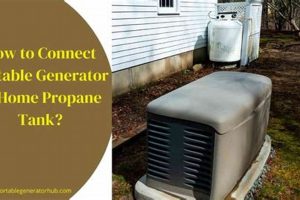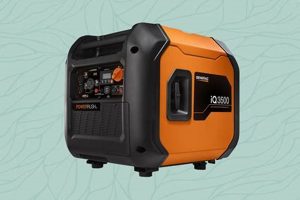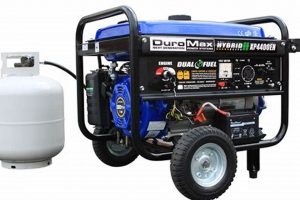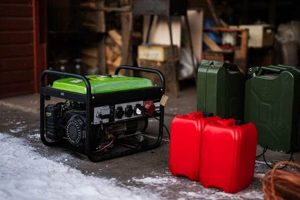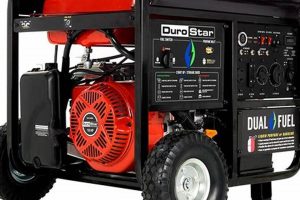Connecting a portable generator to a residential electrical system involves safely and correctly integrating the generator’s power output with the home’s circuits. This typically requires a transfer switch, a device that isolates the home’s wiring from the utility grid while simultaneously connecting it to the generator’s power feed. A properly installed system allows selected circuits to receive power during an outage, preventing backfeeding onto the utility lines, a dangerous condition that risks the lives of utility workers.
Residential generator integration offers significant advantages, providing essential power during utility outages. This capability is particularly crucial for operating critical appliances like refrigerators, freezers, sump pumps, and medical equipment, safeguarding food, preventing property damage, and maintaining essential life support. Historically, homes relied solely on utility power, leaving them vulnerable to extended blackouts. Modern advancements in portable generator technology and safer integration methods have dramatically increased homeowner resilience against power disruptions.
Several crucial aspects must be considered for successful generator integration. These include accurately assessing power needs, selecting an appropriately sized generator and transfer switch, adhering to local electrical codes and permitting requirements, and understanding safe operation and maintenance procedures. The following sections delve into each of these areas, providing detailed guidance for safe and effective home generator installation.
Tips for Safe and Effective Generator Installation
Proper generator installation requires careful planning and execution. These tips offer essential guidance for ensuring safety and functionality.
Tip 1: Accurate Load Calculation: Determine the wattage requirements of essential appliances and equipment intended for generator power. This calculation informs proper generator sizing, preventing overload and ensuring adequate power supply.
Tip 2: Professional Electrical Consultation: Engaging a qualified electrician is crucial. Professional expertise ensures adherence to local electrical codes, safe wiring practices, and proper transfer switch installation.
Tip 3: Proper Generator Placement: Position the generator outdoors in a well-ventilated area, away from windows and doors, to prevent carbon monoxide poisoning. Maintain adequate clearance from combustible materials.
Tip 4: Transfer Switch Selection and Installation: A properly sized transfer switch is essential for safe operation. This device prevents backfeeding and allows seamless switching between utility and generator power. Professional installation is strongly recommended.
Tip 5: Grounding and Bonding: Correct grounding and bonding are crucial safety measures, protecting against electrical shock and ensuring proper equipment function.
Tip 6: Fuel Storage and Handling: Store fuel in approved containers in a well-ventilated location away from ignition sources. Exercise caution when refueling a hot generator.
Tip 7: Regular Maintenance: Adhere to the manufacturer’s recommended maintenance schedule for optimal performance and longevity. This includes oil changes, air filter replacements, and spark plug inspections.
Tip 8: Familiarization with Operation: Thoroughly understand the generator’s starting procedure, controls, and safety features before an outage occurs. Conduct periodic test runs to ensure proper function.
Adhering to these tips helps guarantee a safe and effective generator installation, providing reliable backup power during outages and protecting both the home and its occupants.
By understanding the critical aspects of generator integration and following these guidelines, homeowners can confidently equip themselves with a reliable power source during emergencies.
1. Planning
Effective integration of a portable generator into a home’s electrical system hinges on meticulous planning. This crucial initial phase establishes the framework for a successful installation, ensuring safety, code compliance, and reliable performance during power outages. Planning clarifies requirements and guides subsequent installation steps.
- Load Assessment
Determining the wattage requirements of essential appliances and devices is paramount. This assessment involves identifying which circuits will be powered by the generator during an outage. Examples include refrigerators, freezers, sump pumps, furnaces, and essential lighting. Accurate load calculation ensures the selected generator possesses sufficient capacity, preventing overload and ensuring adequate power supply.
- Transfer Switch Selection
Choosing the correct transfer switch is critical for safety and functionality. Transfer switches safely disconnect the home’s wiring from the utility grid while connecting it to the generator. Options include manual and automatic transfer switches, each with varying levels of convenience and automation. Selecting the appropriate type and capacity ensures proper integration with the home’s electrical system and the generator.
- Location Considerations
Proper generator placement is crucial for safety and performance. Generators must be positioned outdoors in well-ventilated areas, away from windows, doors, and air intakes. Maintaining adequate clearance from combustible materials mitigates fire hazards. Careful consideration of prevailing wind direction minimizes exhaust fumes near the home.
- Permitting and Code Compliance
Adherence to local electrical codes and permitting requirements is essential. Consulting with local authorities and obtaining necessary permits ensures a legal and safe installation. Professional electrical consultation helps navigate code requirements and ensures compliance with safety standards.
These planning facets directly influence the effectiveness and safety of portable generator integration. Careful consideration of load requirements, transfer switch selection, location constraints, and code compliance establishes a solid foundation for a successful installation, providing reliable backup power during outages.
2. Sizing
Correct generator sizing is paramount for successful portable generator integration. An undersized generator will be unable to meet the power demands of the connected appliances, leading to overload and potential damage. Conversely, an oversized generator represents an unnecessary investment and may operate inefficiently at lower loads. Accurate sizing requires a thorough understanding of the home’s electrical needs during an outage.
Calculating the required generator size involves determining the running watts and starting watts of the intended appliances. Running watts represent the power required for continuous operation, while starting watts, often significantly higher, are necessary to initially power on devices with electric motors, such as refrigerators and air conditioners. Summing these values for all intended appliances provides the minimum generator capacity required. For instance, a refrigerator requiring 700 running watts and 1200 starting watts, combined with a sump pump needing 500 running watts and 800 starting watts, necessitates a generator capable of supplying at least 2000 starting watts (1200 + 800) and 1200 running watts (700 + 500).
Failure to correctly size the generator can have significant consequences. Overloading an undersized generator risks damage to the generator itself and connected appliances. It can also create safety hazards due to overheating and potential fire risks. Conversely, an oversized generator operates inefficiently, consuming more fuel than necessary and potentially increasing maintenance costs. Accurate sizing optimizes performance, ensures reliability, and maximizes the return on investment. Consulting a qualified electrician can assist in accurately assessing power requirements and selecting an appropriately sized generator.
3. Transfer Switch
Transfer switches play a crucial role in safely connecting a portable generator to a house. They serve as the critical link between the generator, the home’s electrical system, and the utility grid. Proper transfer switch installation ensures safe operation, prevents backfeeding to the utility lines, and enables a seamless transition between generator and utility power.
- Preventing Backfeeding
Backfeeding, the flow of electricity from the generator back into the utility grid, presents a serious safety hazard to utility workers. Transfer switches prevent backfeeding by isolating the home’s electrical system from the utility lines when the generator is in use. This isolation is crucial for protecting utility personnel working on downed power lines during an outage.
- Safety and Code Compliance
Electrical codes mandate the use of transfer switches for generator connections to ensure safe operation. Improper connections without a transfer switch can lead to electrocution risks and property damage. Transfer switches provide a safe and code-compliant method for integrating generator power.
- Types of Transfer Switches
Two primary types of transfer switches are available: manual and automatic. Manual transfer switches require manual operation to switch between utility and generator power. Automatic transfer switches detect a power outage and automatically start the generator and transfer the load. The choice depends on individual needs and budget.
- Transfer Switch Sizing and Installation
Transfer switches must be appropriately sized to handle the electrical load intended for generator power. Proper installation requires adherence to electrical codes and best practices. Consulting a qualified electrician ensures proper sizing, safe installation, and compliance with local regulations.
Correct transfer switch selection and installation are fundamental components of safely integrating a portable generator with a home’s electrical system. A properly installed transfer switch ensures the safety of utility workers, protects the home’s electrical system, and provides a reliable means of switching between utility and generator power during an outage.
4. Location
Generator location significantly impacts the safety and efficacy of a residential installation. Improper placement can pose life-threatening hazards, primarily due to carbon monoxide (CO) poisoning. CO, a byproduct of combustion engines, is colorless, odorless, and lethal. Positioning a generator too close to the house, particularly near windows, doors, or air intakes, risks drawing exhaust fumes indoors, leading to CO buildup. Cases of CO poisoning related to improper generator placement during power outages are well-documented, underscoring the critical nature of proper location selection. Examples include generators placed in attached garages, on enclosed porches, or too near basement windows, leading to tragic outcomes. Safe distances from the structure, based on prevailing wind direction and manufacturer recommendations, must be maintained.
Beyond CO safety, location also affects generator performance and longevity. Exposure to excessive moisture, debris, or extreme temperatures can damage the generator, reducing its lifespan and reliability. Locations prone to flooding pose additional risks, potentially submerging the generator and causing electrical hazards. A stable, level surface is necessary for safe operation and prevents tipping. Accessibility for refueling and maintenance should also factor into location decisions. Effective location selection involves balancing safety considerations with practical accessibility.
Appropriate generator placement is thus inextricably linked to safe and successful installation. Careful consideration of CO risks, environmental factors, and accessibility ensures both occupant safety and reliable generator operation. Neglecting these location-based considerations can lead to severe consequences, ranging from equipment damage to life-threatening situations. Adherence to manufacturer guidelines and consultation with qualified electricians provides crucial guidance in selecting a suitable location.
5. Connections
Proper connections are paramount for safe and effective portable generator integration. Incorrect wiring can lead to equipment damage, electrical hazards, and even fires. Understanding the various connection types and procedures is essential for a successful and safe installation.
- Generator to Transfer Switch
Connecting the generator to the transfer switch requires heavy-duty extension cords specifically designed for generator use. These cords must be appropriately sized to handle the generator’s output wattage. Incorrectly sized cords can overheat, posing fire risks. The connection should be secure and weatherproof to prevent moisture intrusion. Using improper cords, such as standard household extension cords, can result in voltage drops, equipment damage, and fire hazards.
- Transfer Switch to House Wiring
The transfer switch integrates with the home’s electrical system, allowing selected circuits to receive power from the generator. This connection requires precise wiring according to local electrical codes. Incorrect wiring can damage appliances and create dangerous electrical conditions. Professional installation ensures proper connections and code compliance. Errors in this phase can lead to circuit overloads, appliance damage, and safety hazards.
- Grounding
Proper grounding is crucial for electrical safety. The generator and transfer switch must be grounded according to manufacturer instructions and local electrical codes. Grounding protects against electrical shock and ensures proper equipment operation. Inadequate grounding can result in electrical shock hazards and equipment malfunctions. A grounding rod or connection to the home’s grounding system may be required.
- Bonding
Bonding, the connection of metallic non-current-carrying components, further enhances electrical safety. Proper bonding equalizes electrical potential, minimizing shock risks. This is particularly important for metallic enclosures and frames. Overlooking bonding can create shock hazards, particularly in damp or wet conditions.
Correct connections form the backbone of safe and reliable generator integration. Each connection point, from the generator to the transfer switch and onward to the house wiring, requires meticulous attention to detail and adherence to safety protocols. Ignoring these crucial connection procedures can jeopardize both the functionality of the system and the safety of the home and its occupants. Professional installation ensures the correct implementation of these connections, minimizing risks and ensuring reliable performance during power outages.
6. Safety
Safety is paramount when integrating a portable generator into a residential electrical system. Improper installation and operation can lead to severe consequences, including carbon monoxide poisoning, fire hazards, electrical shock, and damage to appliances. Prioritizing safety throughout the installation process mitigates these risks and ensures the well-being of occupants and utility workers.
- Carbon Monoxide (CO) Poisoning Prevention
CO is a colorless, odorless, and lethal gas produced by combustion engines. Generators must be operated exclusively outdoors in well-ventilated areas, far from windows, doors, and air intakes. Never operate a generator indoors, in attached garages, or in enclosed spaces. CO detectors should be installed and maintained in the home to provide early warning of potential CO buildup. Numerous incidents highlight the tragic consequences of CO poisoning from improperly located generators.
- Fire Hazard Mitigation
Generators pose a fire risk due to the presence of fuel and heat. Store fuel in approved containers in a well-ventilated area away from ignition sources. Allow the generator to cool before refueling. Maintain adequate clearance around the generator, keeping it away from combustible materials such as dry leaves, wood, and flammable liquids. Fire incidents related to improper fuel storage and generator placement underscore the importance of fire safety precautions.
- Electrical Shock Prevention
Proper grounding and bonding are essential for preventing electrical shock. Ensure the generator and transfer switch are correctly grounded according to manufacturer instructions and local electrical codes. Avoid operating the generator in wet or damp conditions. Dry hands thoroughly before handling the generator or connection cords. Electrical shock incidents often result from improper grounding or contact with energized components.
- Appliance and Equipment Protection
Correctly sizing the generator and using a properly installed transfer switch protects appliances and equipment from damage. Overloading the generator or backfeeding onto the utility grid can damage sensitive electronics and appliances. Adhering to proper connection procedures and load management strategies safeguards connected devices. Damage to appliances from generator overload highlights the importance of proper sizing and load management.
Integrating a portable generator into a home’s electrical system requires meticulous attention to safety. Prioritizing CO poisoning prevention, fire hazard mitigation, electrical shock prevention, and appliance protection ensures the well-being of occupants and the proper functioning of the system. Negligence in any of these areas can result in serious consequences. Adhering to safety guidelines and consulting with qualified professionals minimizes risks and provides peace of mind during power outages.
7. Testing
Systematic testing validates the proper integration and functionality of a portable generator within a residential electrical system. This crucial step confirms the efficacy of the installation, ensuring reliable performance during actual power outages. Testing verifies correct operation of the transfer switch, adequate power delivery to designated circuits, and the absence of backfeeding onto the utility grid. Neglecting this phase risks discovering critical flaws during an actual emergency, potentially leading to appliance damage, safety hazards, or insufficient power supply when it’s most needed. For instance, a faulty transfer switch might fail to isolate the house from the utility grid, posing risks to utility workers. Alternatively, an improperly sized generator might overload during testing, revealing inadequate capacity before a critical outage. Examples of real-world scenarios underscore the critical nature of preemptive testing.
Effective testing involves a simulated power outage. This simulation typically requires temporarily disconnecting the main utility breaker and starting the generator. With the generator powering the home through the transfer switch, selected circuits should be energized, while others remain de-energized, mirroring the intended configuration during a real outage. Measuring voltage and current at various points confirms proper power delivery and load distribution. Simultaneously, verification of utility grid isolation is crucial. This verification might involve monitoring voltage at the utility meter or using specialized equipment to confirm the absence of backfeeding. Documenting test results provides valuable records for future reference and maintenance planning. Consistent testing regimens, performed periodically, ensure ongoing system reliability.
Rigorous testing transforms a theoretical installation into a demonstrably functional backup power solution. It bridges the gap between planned functionality and real-world performance, mitigating risks and ensuring the system performs as intended when needed most. Challenges may arise during testing, revealing underlying wiring issues, inadequate generator capacity, or transfer switch malfunctions. Addressing these challenges proactively strengthens the system’s reliability, ultimately contributing to the overarching goal of reliable backup power. Testing finalizes the installation process, confirming the system’s preparedness for real-world outage scenarios.
Frequently Asked Questions
This section addresses common inquiries regarding safe and effective portable generator integration with residential electrical systems. Understanding these aspects is crucial for ensuring proper functionality, safety, and code compliance.
Question 1: Is professional installation required for connecting a portable generator?
While technically possible to perform a self-installation, professional installation by a qualified electrician is strongly recommended. Electricians possess the expertise to ensure adherence to local electrical codes, safe wiring practices, and proper transfer switch integration, mitigating potential hazards.
Question 2: What size generator is needed to power essential household appliances?
Generator sizing depends on the specific wattage requirements of the appliances intended for backup power. Calculating the combined running watts and starting watts of these appliances determines the minimum generator capacity needed. Consulting an electrician assists in accurate load assessment and proper generator selection.
Question 3: Can a portable generator be connected directly to a home’s electrical panel?
Direct connection to an electrical panel without a properly installed transfer switch is unsafe and violates electrical codes. This practice risks backfeeding, endangering utility workers and potentially damaging appliances. A transfer switch isolates the home’s wiring from the utility grid during generator operation.
Question 4: Where should a portable generator be placed during operation?
Generators must be operated outdoors in well-ventilated areas, far from windows, doors, and air intakes. This placement minimizes carbon monoxide poisoning risks. Maintaining adequate clearance from combustible materials mitigates fire hazards.
Question 5: What type of extension cord is suitable for connecting a generator to a transfer switch?
Heavy-duty extension cords specifically designed for generator use are required. These cords are rated for higher wattage and feature durable construction. Using standard household extension cords can lead to overheating, voltage drops, and potential fire hazards.
Question 6: How frequently should a portable generator be tested?
Periodic testing, ideally every few months, ensures reliable operation during an actual outage. Testing involves simulating a power outage, starting the generator, and verifying proper power delivery to designated circuits and the absence of backfeeding. Regular testing identifies potential issues early, allowing for timely maintenance and repairs.
Understanding these frequently asked questions provides a foundational understanding of safe and effective portable generator integration. However, consulting with a qualified electrician remains essential for site-specific guidance and adherence to local electrical codes. Professional expertise ensures a safe, code-compliant, and reliable installation.
The subsequent section provides additional resources for further research and information.
Conclusion
Safe and effective portable generator integration requires careful consideration of several interconnected factors. Load assessment, proper generator sizing, transfer switch selection and installation, strategic location planning, secure connections, adherence to safety protocols, and systematic testing are crucial for successful implementation. Overlooking any of these aspects can compromise safety, jeopardize equipment, and render the backup power system ineffective during an outage. Professional electrical consultation ensures adherence to local codes, mitigates risks, and optimizes system performance.
Residential power outage preparedness necessitates a comprehensive approach. Thorough planning, professional guidance, and diligent execution transform a portable generator from a simple appliance into a reliable source of backup power, enhancing household resilience and ensuring safety during critical power disruptions. Investing in a robust and properly integrated generator system provides peace of mind and safeguards against the disruptions and potential dangers of extended power outages.

